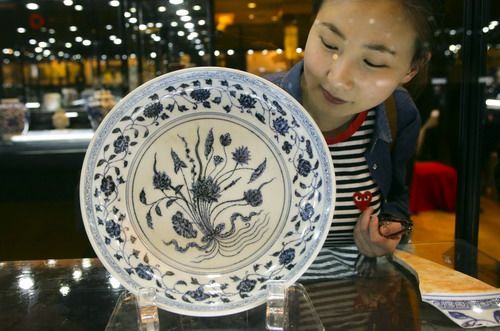Investors get the picture with art
Updated: 2012-05-18 11:03
By Zhu Jin, Pei Pei and Jiang Xueqing in Beijing (China Daily)
|
||||||||
|
 |
|
A visitor examines a plate from the Ming Dynasty (1368-1644). It is one of artworks that will be auctioned in Beijing on May 19 by the International Auction Company of China. [Photo/ China News Service] |
"Although the Mei Moses Art Index is open for anyone to check, the methodology behind it is not understood by everybody. Professor Mei applies the methodology to practical investment and combines it with a trading database to make a rational valuation. It is totally different from relying on an individual's perceptual judgment," said BAM's Dong, adding that other art investment funds also base their valuations on analysis of trading figures.
In addition to valuation, risk control is a crucial factor in art investment. "The more important an artwork, the easier it is to establish its authenticity," said Huang of Bonwin. "There are a number of reference points to rely on and they make it extremely hard to forge a well-known piece of art."
He said Bonwin has built an appraisal system with strict rules and procedures that prevent the company from investing in any work of art if a flaw - no matter how tiny - is detected.
BAM, which focuses on contemporary art, said it's able to confirm the authenticity of a piece either with the current owner or the artist who created it, significantly reducing the investment risk. In addition, the company requires copies of all legal documents that ensure provenance and ownership.
Dong said that returns also depend on whether a company is able to continuously increase the added valued of its artworks, because the value of a piece is closely related to its appearance at major exhibitions and inclusion in publications.
In cooperation with the China Arts and Entertainment Group, BAM founded an exhibition company to make its artworks available to a growing number of influential exhibitions overseas. That increases the added value of the artwork and can also boost its price in the primary market.
Speculative bubbles
However, the extremely high prices that some pieces fetch at auction make some observers suspect that speculative bubbles have flooded the market and will burst sooner or later. "A growing number of bubbles have appeared in the auction market, partly because the Chinese have a penchant for gambling and also because it is seen to be more civilized to speculate on art, rather than garlic," said Dong.
Having reflected on this phenomenon, industry insiders now believe that many works are seriously overvalued. But according to Professor Feng of UIBE, auction market fever does not always translate into art market frenzy. That's because auctions operate on the secondary market, while art investment funds usually acquire their works in the primary market, buying directly from artists or collectors.
The financialization of art has also brought a large number of financial professionals into the art market, which can help to prevent irrational investment.
"In the past, collectors entertained themselves in the old market. But now, as more financial institutions become involved, they require standardization. The emergence of art investment funds has played an effective role in achieving that aim, the standardization of the market," according to Dong.
She noted that the market's current trajectory is related to its relatively minor presence when compared with stocks, bonds and other investment vehicles. Currently, China still lacks appraisal institutions good enough to gain recognition from the financial agencies and the punishments for selling forgeries are not severe enough. "Although the art market is not perfect, it will mature gradually, just like the stock market," said Dong.
As an increasing number of individual investors enter the market, the financial institutions promoting art investment funds have been making greater efforts to cultivate appreciation and consumption of the arts. Believing the market has great potential, they explained that if moderately wealthy individuals purchased pieces worth 200,000 to 300,000 yuan, consumption would ripple out from them to other groups.
"The art investment market is a 'blue ocean', although it is not standardized in certain aspects," said Dong, referring to the Blue Ocean business strategy that seeks to achieve growth and profits by generating new demand in previously uncontested markets.
"The government has put great emphasis on the market and, therefore, more capital and talent will flow in. As an increasing number of elite players gather in the cultural field, it will present a great opportunity for the development of the Chinese art investment industry," she said.
Contact the reporters at zhujin@chinadaily.com.cn, peipei@chinadaily.com.cn

 Relief reaches isolated village
Relief reaches isolated village
 Rainfall poses new threats to quake-hit region
Rainfall poses new threats to quake-hit region
 Funerals begin for Boston bombing victims
Funerals begin for Boston bombing victims
 Quake takeaway from China's Air Force
Quake takeaway from China's Air Force
 Obama celebrates young inventors at science fair
Obama celebrates young inventors at science fair
 Earth Day marked around the world
Earth Day marked around the world
 Volunteer team helping students find sense of normalcy
Volunteer team helping students find sense of normalcy
 Ethnic groups quick to join rescue efforts
Ethnic groups quick to join rescue efforts
Most Viewed
Editor's Picks

|

|

|

|

|

|
Today's Top News
Health new priority for quake zone
Xi meets US top military officer
Japan's boats driven out of Diaoyu
China mulls online shopping legislation
Bird flu death toll rises to 22
Putin appoints new ambassador to China
Japanese ships blocked from Diaoyu Islands
Inspired by Guan, more Chinese pick up golf
US Weekly

|

|






